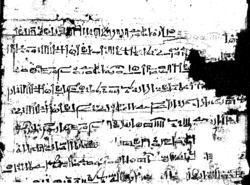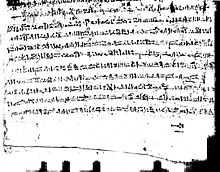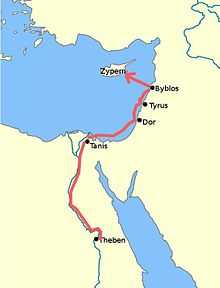Story of Wenamun
| Story of Wenamun | |
|---|---|
| Pushkin Museum | |
 | |
| Also known as | Moscow Papyrus 120 |
| Type | Papyrus |
| Date | c.1000 BCE |
| Place of origin | al-Hibah, Egypt |
| Language(s) | Hieratic |
| Scribe(s) | Unknown |
| Discovered | 1890 |
The Story of Wenamun (alternately known as the Report of Wenamun, The Misadventures of Wenamun, Voyage of Unamūn, or [informally] as just Wenamun) is a literary text written in hieratic in the Late Egyptian language. It is only known from one incomplete copy discovered in 1890 at al-Hibah, Egypt, and subsequently purchased in 1891 in Cairo by the Russian Egyptologist Vladimir Goleniščev.[1] It was found in jar together with the Onomasticon of Amenope and the Tale of Woe.
The papyrus is now in the collection of the Pushkin Museum of Fine Arts, Moscow, and officially designated as Papyrus Pushkin 120. The hieratic text is published by Korostovcev 1960, and the hieroglyphic text is published by Gardiner 1932 (as well as on-line).
Discovery
The two-page papyrus is unprovenanced. It was reported to have been discovered in an illicit excavation at al-Hibah, Egypt and was bought by Vladimir Goleniščev in 1891-92. Golenisheff published the manuscript in 1897-99.
The text

The story is set in a "Year 5", generally taken to be year 5 of the so-called Renaissance of Pharaoh Ramesses XI, the tenth and last ruler of the Twentieth Dynasty of Ancient Egypt (1190 - 1077 BCE). Egberts (1991) argues, however, that the story is set in the fifth regnal year of Smendes I, the Delta-based founder of the Twenty-first Dynasty.
As the story begins, the principal character, Wenamun, a priest of Amun at Karnak, is sent by the High Priest of Amun Herihor to the Phoenician city of Byblos to acquire lumber (probably cedar wood) to build a new ship to transport the cult image of Amun. After visiting Smendes (Nesbanebded in Egyptian) at Tanis, Wenamun stopped at the port of Dor ruled by the Tjeker prince Beder, where he was robbed. Upon reaching Byblos, he was shocked by the hostile reception he received there. When he finally gained an audience with Zakar-Baal, the local king, the latter refused to give the requested goods for free, as had been the traditional custom, instead demanding payment. Wenamun had to send to Smendes for payment, a humiliating move that demonstrates the waning of Egyptian power over the Eastern Mediterranean. After a wait of almost a year at Byblos, Wenamun attempted to leave for Egypt, only to be blown off course to Alashiya (Cyprus), where he was almost killed by an angry mob before placing himself under the protection of the local queen, whom he called Hatbi. At this point the story breaks off.
Analysis

It was once widely believed that the Story of Wenamun was an actual historical account, written by Wenamun as a report regarding his travels. However, literary analysis conducted by Egyptologists since the 1980s (Helck 1986) indicates that it is a work of historical fiction, a view now generally accepted by most professionals working on the text. As Sass (2002) summarized the situation, "In recent years most Egyptologists have come to regard Wenamun as a work of fiction, composed after the events it relates, its value as a historical source rather limited (see also end of Section 4). On the other hand students of the Ancient Near East and of Egypto-Levantine connections, thirsting as they are after every scrap of written information, often still treat Wenamun practically as a primary historical source of the late 20th dynasty." As examples of the latter approach, Sass cites Mazar (1992), Kitchen (1996), Millard (1998), Yurco (1999), Ward (1999), Markoe (2000), Leahy (2001), and Weinstein (2001). For details on the former approach, see Baines 1999; Scheepers 1992; Egberts 2001; Sass 2002; Schipper 2005. Jaroslav Černý found that the text had no corrections, and was apparently written without any interruptions, such as would have been caused by simultaneously composing the document. In general, the literary character of the text is summed up by Egberts (2001:495) as being apparent from the sophisticated plot, the rhetoric and irony of the dialogues, the imagery, and the underlying reflection on political, theological, and cultural issues. Specific grammatical features also point to the literary nature of the text. Moreover, the palaeography of the text points to a Twenty-second Dynasty date for its composition (Caminos 1977:3; Helck 1986:1215), as well as a number of anachronisms more reflective of a post-Twentieth or Twenty-first Dynasty time frame (Sass 2002; Sass specifically states it was written during the reign of Shoshenq I).
The text also ends abruptly, possibly showing that the person writing the text down was only interested in the first part of the narrative, and stopped when he realized that he had continued too far into the return journey. Finally, at the end of the text, in a slightly larger hand, the syllable (copy) is written, showing that it is not the original.
It is quite possible that the copy we have may date as much as one-hundred and fifty years later than the original. The first reason for this assumption is that the post-script is used. This is otherwise only used in the twenty-second dynasty (945-715 BCE). The other reason is the locale where the document was discovered—the Upper Egyptian town of al-Hibah. This town only gained any degree of importance under the reigns of Shoshenq I and Osorkon I. There was also apparently a renewed interest in the affairs of the Levant during the twenty-second dynasty.
The author of Wenamun possibly wrote the original manuscript as an administrative document, a report of his journeys. However, the man who had the document copied over a century later most likely had a different reason. When theorizing about the purposes of the copyist, it seems to be all-too-common to forget about the reverse side of the papyrus. This concerns, as near as we can tell, the "sending of commodities by Ni-ki.. through the agency of Ne-pz-K-r-t for unspecified payment." It could be that this is a summarization of an attempt to perform a mission similar to that of Wenamun in this later time. The Journey of Wenamun to Phoenicia, then, may have been copied as a preparation for this later trip.
Importance of the document
The Story of Wenamun is an unparalleled source for learning of conditions in Egypt, as well as in Phoenicia. One can also see from this document, as from no other of the period, common attitudes toward religion (especially the cult of Amon), the state of Mediterranean shipping practises, and even the attitudes of foreign princes to Egyptian claims of supremacy in the region. Even the supremacy of the pharaoh in Egypt is placed under our scrutiny. The current pharaoh, Ramesses XI, is never even mentioned during Wenamun's journey. Thebes, Wenamun's hometown, is under the control of Herihor--the High Priest of Amon. The authority Wenamun goes to see in the delta is Smendes, who resides at Tanis, and bears the never-before-seen title "organizer-of-the-country". It is worthy of note that neither Smendes nor Herihor bear any royal title whatsoever. Overall, the Story of Wenamun presents to us what could possibly be the most vivid and descriptive narrative of pre-classical times.
Because the text is based on a historical framework, it remains particularly useful to historians for the study of the late New Kingdom and early Third Intermediate Period. They often treat the text as a primary source of the late 20th Dynasty. The Story of Wenamun was discovered with another historical fiction, the so-called Tale of Woe [Papyrus Pushkin 127], which takes the form of an imaginative letter as a vehicle to convey a narrative; see Caminos 1977 for discussion of both works.
References
- ↑ (Caminos 1977:1).
- Baines, John R. 1999. "On Wenamun as a Literary Text". In Literatur und Politik im pharaonischen und ptolemäischen Ägypten: Vorträge der Tagung zum Gedenken an Georges Posener 5.–10. September 1996 in Leipzig, edited by Jan Assmann, and Elke Blumenthal. Bibliothèque d'Étude 127. Cairo: Imprimerie de l'Institut français d'archéologie orientale du Caire. 209–233.
- Caminos, Ricardo Augusto. 1977. A Tale of Woe from a Hieratic Papyrus in the A. S. Pushkin Museum of Fine Arts. Oxford: The Griffith Institute.
- Černý, J. 1952. Paper and books in Ancient Egypt. An inaugural lecture delivered at University College, London, 29 May 1947., London: H. K. Lewis.
- Egberts, Arno. 1991. "The Chronology of The Report of Wenamun." Journal of Egyptian Archæology 77:57–67.
- ———. 1998. "Hard Times: The Chronology of 'The Report of Wenamun' Revised", Zeitschrift fur Ägyptischen Sprache 125 (1998), pp. 93–108.
- ———. 2001. "Wenamun". In The Oxford Encyclopedia of Ancient Egypt, edited by Donald Bruce Redford. Vol. 3 of 3 vols. Oxford, New York, and Cairo: Oxford University Press and The American University in Cairo Press. 495–496.
- Eyre, C.J. [1999] "Irony in the Story of Wenamun", in Assmann, J. & Blumenthal, E. (eds), Literatur und Politik im pharaonischen und ptolemäischen Ägypten, IFAO: le Caire, 1999, pp. 235–252.
- Gardiner, Alan Henderson. 1932. Late-Egyptian Stories. Bibliotheca aegyptiaca 1. Brussel: Fondation égyptologique reine Élisabeth. Contains the hieroglyphic text of the Story of Wenamun.
- Goedicke, Hans. 1975. The Report of Wenamun. Baltimore: Johns Hopkins University Press.
- Helck, Hans Wolfgang. 1986. "Wenamun". In Lexikon der Ägyptologie, edited by Hans Wolfgang Helck and Wolfhart Westendorf. Vol. 6 of 7 vols. Wiesbaden: Otto Harrassowitz. 1215–1217
- Kitchen, Kenneth A., 1996. The Third Intermediate Period in Egypt, 1100-650BC. Warminster: Aris and Phillips, XVI-XVII.
- Коростовцев, Михаил Александрович [Korostovcev, Mixail Aleksandrovič]. 1960. Путешествие Ун-Амуна в Библ Египетский иератический папирус №120 Государственного музея изобразительных искусств им. А. С. Пушкина в Москве. [Putešestvie Un-Amuna v Bibl: Egipetskij ieratičeskij papirus No. 120 Gosudarstvennogo muzeja izobrazitel'nyx iskusstv im. A. S. Puškina v Mockva.] Памятники литературы народов востока (Волъшая серия) 4. [Moscow]: Академия Наук СССР, Институт Востоковедения [Akademija Nauk SSSR, Institut Vostokovedenija].
- Leahy, A. 2001. "Sea Peoples" in Oxford Encyclopedia of Ancient Egypt. Oxford, Vol. 3, 257–260.
- Leprohon, R.J. 2004. "What Wenamun Could Have Bought: the Value of his Stolen Goods", Egypt, Israel, and the Ancient Mediterranean World: Studies in Honor of Donald B. Redford (ed. G.N. Knoppers and A. Hirsch; Probleme der Ägyptologie; Leiden: E. J. Brill, 2004)
- Markoe, Glenn E.. 2000. Phoenicians. London: British Museum Press.
- Mazar, Amihay. 1992. Archaeology of the Land of the Bible, 10,000–586 B.C.E.. New York: Doubleday, 305-306.
- Millard, A. 1998 "Books in the Late Bronze Age in the Levant" in Israel Oriental Studies Vol 18 (Anson F. Rainey festschrift), 171–181.
- Sass, Benjamin. 2002. "Wenamun and His Levant—1075 BC or 925 BC?" Ägypten und Levante 12:247–255.
- Scheepers, A. 1992. "Le voyage d'Ounamon: un texte 'littéraire' ou 'non-littéraire'?" In Amosiadès: Mélanges offerts au professeur Claude Vandersleyen par ses anciens étudiants, edited by Claude Obsomer and Ann-Laure Oosthoek. Louvain-la-neuve: [n. p.]. 355–365
- Schipper, Bernd Ulrich. 2005. Die Erzählung des Wenamun: Ein Literaturwerk im Spannungsfeld von Politik, Geschichte und Religion. Orbis Biblicus et Orientalis 209. Freiburg and Göttingen: Universitätsverlag Freiburg and Vandenhoeck & Ruprecht. ISBN 3-525-53067-6
- de Spens, Renaud. 1998. « Droit international et commerce au début de la XXIe dynastie. Analyse juridique du rapport d'Ounamon », in Le commerce en Egypte ancienne, éd. par N. Grimal et B. Menu (BdE 121), Le Caire, p. 105-126 at Thotweb.com.
- Ward, W.A., 1999. "Sea Peoples" in Encyclopedia of the Archaeology of Ancient Egypt, edited by K.A. Bard, New York, 718-721,843.
- Weinstein, J. 2001. "Lebanon" in Oxford Encyclopedia of Ancient Egypt, Oxford, vol. 2, 284–286.
- Yurco, Frank J, 1998. "Trade, Foreign" in Encyclopedia of the Archaeology of Ancient Egypt, edited by K.A. Bard, New York, 719-720.